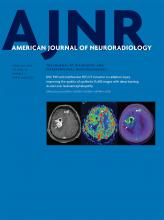Abstract
BACKGROUND AND PURPOSE: The prediction of treatment response is important in planning and modifying the chemoradiation therapy regimen. This study aimed to explore the quantitative histogram indices for treatment-response prediction of nasopharyngeal carcinoma based on diffusional kurtosis imaging compared with a standard ADC value (ADCstandard).
MATERIALS AND METHODS: Thirty-six patients with an initial diagnosis of locoregionally advanced nasopharyngeal carcinoma and diffusional kurtosis imaging acquisitions before and after neoadjuvant chemotherapy were enrolled. Patients were divided into respond-versus-nonrespond groups after neoadjuvant chemotherapy and residual-versus-nonresidual groups after radiation therapy. Histogram parameters of diffusional kurtosis imaging–derived parameters (ADC, ADC coefficient corrected by the non-Gaussain model [D], apparent kurtosis coefficient without a unit [K]) were calculated. The ADCstandard was calculated on the basis of intravoxel incoherent movement data. The intraclass correlation coefficient, Kolmogorov-Smirnov test, Student t test or Mann-Whitney U test, and receiver operating characteristic analysis were performed.
RESULTS: Most of the parameters had good-to-excellent consistency (intraclass correlation coefficient = 0.675–0.998). The pre-ADCstandard, pre-ADC (10th, 25th, 50th percentiles), pre-D (10th, 25th, 50th percentiles), and pre-K50th were significantly different between the respond and nonrespond groups, while the pre-ADC10th, pre-K90th, post-ADC50th, post-K75th, post-K90th, and the percentage change of parameters before and after neoadjuvant chemotherapy (▵ADC50th%) were significantly different between the residual and nonresidual groups (all P < .05). Receiver operating characteristic analysis indicated that setting pre-D50th = 0.875 × 10−3mm2/s as the cutoff value could result in optimal diagnostic performance for neoadjuvant chemotherapy response prediction (area under the curve = 0.814, sensitivity = 0.70, specificity = 0.92), while the post-K90th = 1.035 (area under the curve = 0.829, sensitivity = 0.78, specificity = 0.72), and▵ADC50th% = 0.253 (area under the curve = 0.833, sensitivity = 0.94, specificity = 0.72) were optimal for radiation therapy response prediction.
CONCLUSIONS: Histogram analysis of diffusional kurtosis imaging may potentially predict the neoadjuvant chemotherapy and short-term radiation therapy response in locoregionally advanced nasopharyngeal carcinoma, therefore providing evidence for modification of the treatment regimen.
ABBREVIATIONS:
- CR
- complete response
- D
- ADC coefficient corrected by the non-Gaussain model
- DKI
- diffusional kurtosis imaging
- IMRT
- intensity-modulated radiation therapy
- K
- apparent kurtosis coefficient without a unit
- NAC
- neoadjuvant chemotherapy
- NPC
- nasopharyngeal carcinoma
- PR
- partial response
- SD
- stable disease
- ▵ADC50th%
- the percentage change of parameters before and after neoadjuvant chemotherapy
- © 2019 by American Journal of Neuroradiology
Indicates open access to non-subscribers at www.ajnr.org












